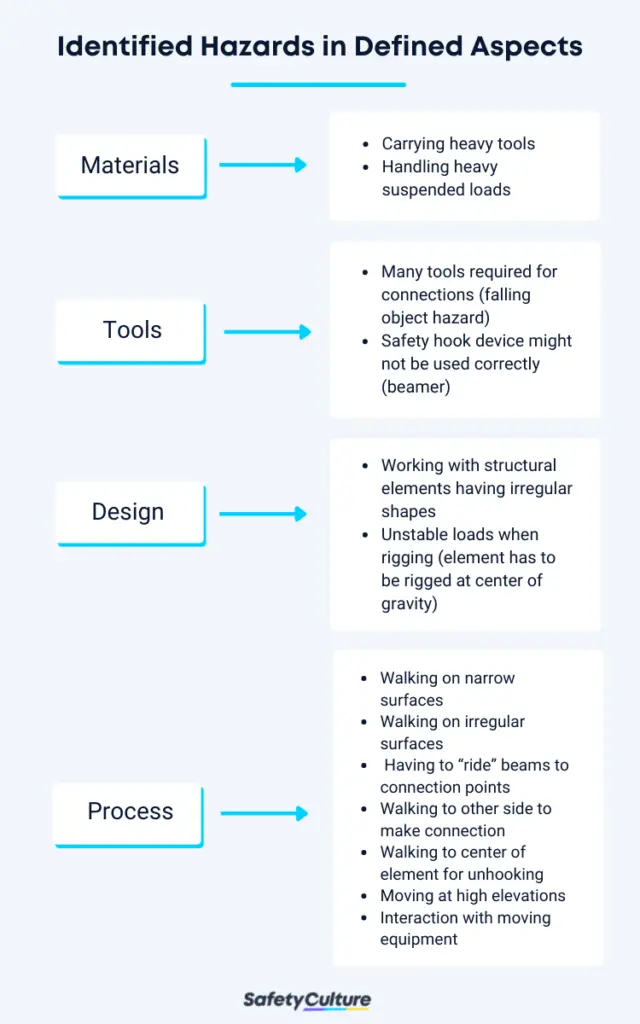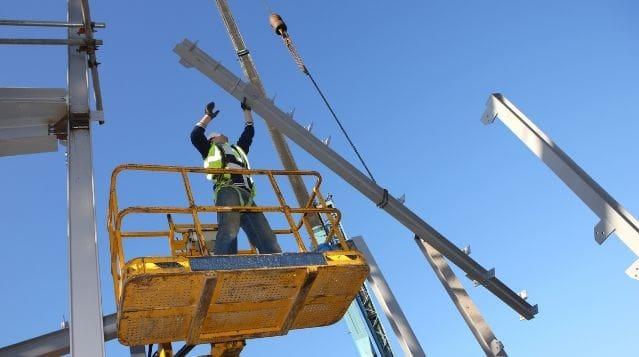What is Steel Erection?
Steel erection is the process of constructing, altering, or repairing steel buildings, bridges, and other structures. It also involves the assembly, connection, and installation of steel beams, metal decking, and planking used in the erection of a steel structure. Steel workers assigned in steel erection activities are commonly employed in building, contracting, and construction companies.
The Occupational Safety and Health Administration (OSHA) recognizes steel erection as one of the 10 most hazardous occupations in the US and has laid down regulations to promote safety for workers.
According to the International Labour Organization (ILO), the structural steel erection process involves:
- setting up hoisting equipment for raising and placing structural-steel members;
- raising, placing, and uniting girders, columns, and other structural-steel members for the formation of completed structures or structure frameworks;
- fastening steel members to cable hoist using a chain, cable, or rope;
- pulling, pushing, or prying steel members into approximate positions while member is supported by a hoisting device;
- forcing members into final position using turnbuckles, crowbars, jacks, and hand tools;
- aligning rivet holes in member with corresponding holes in previously placed member by driving drift pins or the handle of a wrench through holes;
- verifying vertical and horizontal alignment of members using plumb bob and level;
- bolting aligned members to keep them in position until they can be permanently riveted, bolted, or welded in place;
- catching hot rivets tossed by rivet heater (heat treating) in bucket and inserting rivets in holes using tongs; and
- cutting and welding steel members to make alterations using oxyacetylene welding equipment.
Hazards
The risks and hazards associated with steel structure erection vary at each location, depending on the types of materials, sizes of structures, and other working conditions. Prior to any project, a comprehensive job hazard analysis is required to identify the potential risks and establish appropriate safety plans.
Identified Hazards in the Steel Erection Process

Source: Effect of Safety and Environmental Variables on Task Durations in Steel Erection (Irizarry et al., 2005)
“Effect of Safety and Environmental Variables on Task Durations in Steel Erection” (Irizarry, Simonsen, & Abraham) lists the major identified hazards involved in the steel erection process:
- Materials – carrying heavy tools and handling heavy suspended loads
- Tools – using tools needed for connections exposes workers to falling object hazards
- Design – working with structural elements that have irregular shapes and unstable loads when rigging
- Process – walking on narrow and irregular surfaces, to the other side to make connections, and to the center of element for unhooking; moving at high elevations; and interacting with moving equipment
Causes of Steel Erection Accidents
Data from OSHA show that steel erection accidents leading to fatalities are often due to the following factors:
- Premature crane disconnections before the piece was secured
- Workers landing or placing a load on unsecured or unabridged joists
- Workers getting hit by objects while walking or working under a load
- Workers being struck by objects while landing a load or making a connection, by a tool slipping, or by a piece of decking being blown off a pile when fall protection is neither provided nor used
- Failure to use available fall protection systems even though the worker was wearing a safety harness
- Stepping onto or working on unsecured decking that slipped out of place when fall protection was neither provided nor used
- Workers not being tied off while at the workstation
- Walking or standing on the beam/joist where fall protection wasn’t provided or used, resulting in slips, trips, and falls
- Flying metal splinters; working with a chisel and hammer; and conducting sharpening, cutting, or welding works without using Personal Protective Equipment (PPE), resulting in eye injury
- Lifting and moving heavy loads, causing back and spinal column injury
- Touching live electrical wires or working with portable power tools which may lead to electrocution
- Exposure to high noise levels
OSHA Regulations
OSHA’s Construction Standards, known as the 29 CFR 1926, covers regulations for steel erection under the Subpart R. This set of guidelines includes the following:
- 1926.750 – Scope
- 1926.751 – Definitions
- 1926.752 – Site layout, site-specific erection plan, and construction sequence
- 1926.753 – Hoisting and rigging
- 1926.754 – Structural steel assembly
- 1926.755 – Column anchorage
- 1926.756 – Beams and columns
- 1926.757 – Open web steel joists
- 1926.758 – Systems-engineered metal buildings
- 1926.759 – Falling object protection
- 1926.760 – Fall protection
- 1926.761 – Training
In addition to these, there are other standards that are also related to steel erection, such as:
- 29 CFR 1926 Subpart CC – cranes and derricks
- 29 CFR 1926.502 – fall protection systems criteria and practices
How to Improve Steel Erection Safety
As the ILO recommends, the preventive measures that steel erection companies must consider implementing include:
- ensuring that employees are using ladders in good working order and appropriately placed to prevent slipping;
- requiring the use of PPE that is suited for the type of work;
- training employees on safe techniques for raising and lowering loads;
- doing regular maintenance and routine checks on portable power tools and equipment;
- providing employees with work clothes that are apt for conditions of the workplace;
- evaluating the safety of scaffolding components before work starts; and
- enforcing the necessary medical, technical, and administrative procedures for preventing injuries caused by hand-arm vibrations.
Improve your EHS Management
Cultivate a safe working environment and streamline compliance with our EHS solutions.
Explore nowEmployee training is essential to any steel erection accident prevention program. For improved safety in steel erection activities, all training programs must be compliant with the following requirements, as stated in OSHA’s training guide:
- Training is completed according to the requirements stated under 1926.761
- Training has been approved by the US Department of Labor Apprenticeship
Aside from the requirements above, steel erection safety training must meet the following conditions:
- Qualified person – Only those with recognized knowledge, skills, or experience can conduct steel erection training.
- Fall hazards – Employers must also ensure that employees exposed to fall hazards are well-trained and instructed on the requirements of the standard.
- Special training programs – Steel workers who are involved in multiple-lift rigging operations, connector procedures, and Controlled Decking Zones (CDZs) must be given special training.
To help you get everyone on board toward promoting a culture of safety and quality, take your training initiatives to the next level.
Protect Your Workers with SafetyCulture
Using operations inspection software such as SafetyCulture (formerly iAuditor) empowers your organization in ensuring the safety of your frontline workers. Conduct effective training programs and stay on top of industry standards and regulations by maximizing SafetyCulture’s dynamic features:
- Create and share customized templates for real-time and scheduled inspections to keep everyone informed of the latest updates and standards
- Convert your daily processes into logical, digital workflows
- Spot issues on the worksite (such as equipment failures, lack of appropriate PPEs, and insufficient manpower) and attach reference media for proper documentation
- Notify the persons-in-charge on project updates, issues, and other key workplace communications via Heads Up
- Complete site inspections to generate reports and access analytics to see areas for improvement and maintain compliance
- Work better together by assigning collaborative actions, setting priority levels, and adding context to tasks




